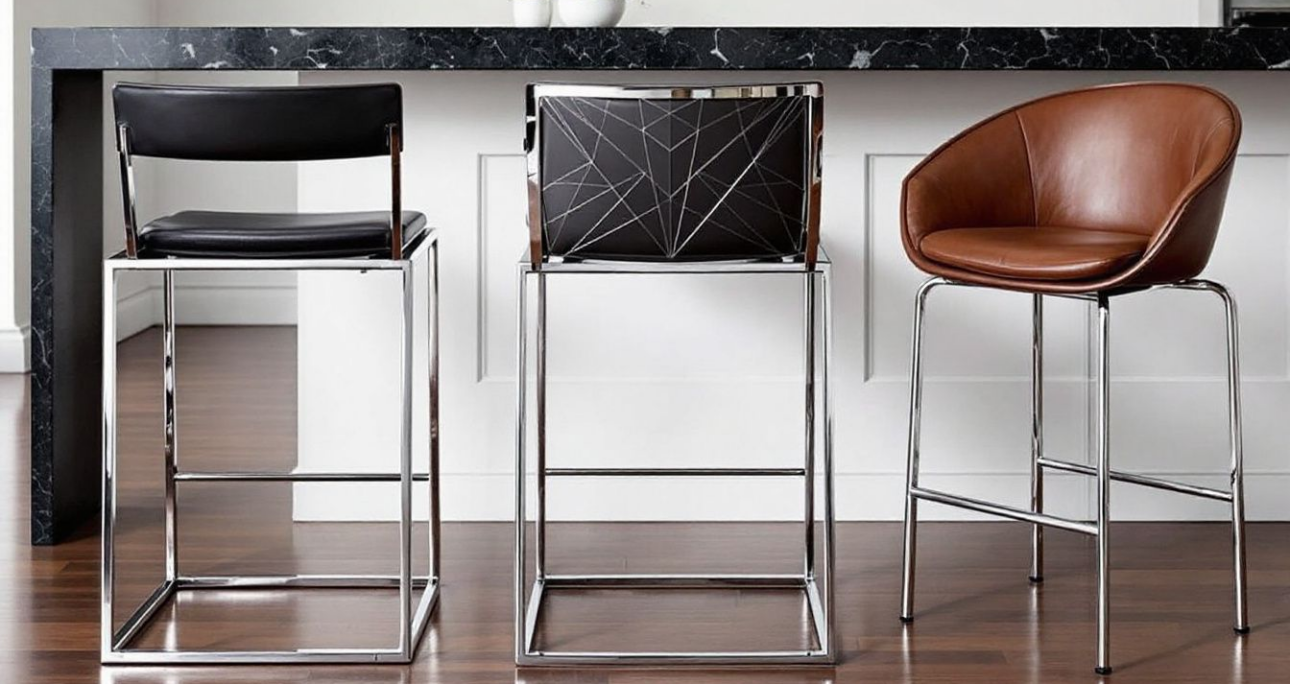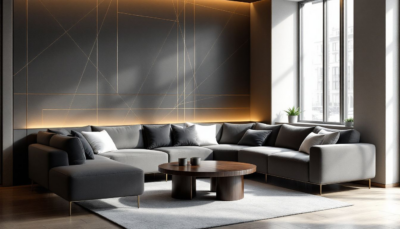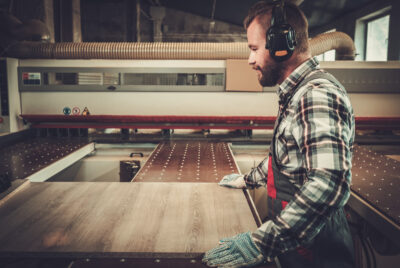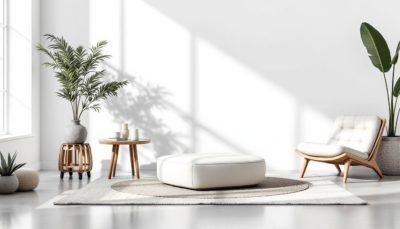Physical vapour deposition (PVD) is a process that deposits thin films onto surfaces at the atomic level, boosting hardness, wear resistance, and creating durable coatings. It’s essential in industries like furniture for creating durable, high-performance parts through physical vapour deposition techniques. This article covers what PVD is, its mechanisms, and its key applications.
Key Takeaways
Physical Vapor Deposition (PVD) is a versatile coating process that enhances material properties at the atomic level, suitable for furniture.
The PVD process involves vaporizing solid materials in a high vacuum environment, leading to thin film coating that is thin, durable, and high-quality, improving performance, hardness, and wear resistance.
PVD coatings are non-toxic, environmentally friendly, and highly resistant to abrasion and corrosion, making them ideal for use in high-traffic and sensitive environments like homes and medical facilities.
What is Physical Vapor Deposition?
Physical vapor deposition, or PVD for short, employs a coating process that bonds extremely thin layers of material onto surfaces at an atomic scale. Leveraging the capabilities of physical vapor deposition technology, this procedure aims to boost certain features of materials by adding coatings that enhance their tribological and aesthetic qualities among others. The films applied through the physical vapor deposition (PVD) method are exceedingly thin yet remarkably effective in providing improvements unattainable with conventional techniques.
The adaptability of PVD stands out as one of its most remarkable benefits. Employed across various sectors such as automotive, aerospace, and particularly within the furniture industry. PVD allows manufacturers to produce components and finishes that are not only durable but also resistant to wear while maintaining visual attractiveness.
Imagine a scenario where everyday objects—from the smooth handle on your door to the lustrous top of your dining room table—are not merely pleasant to view but constructed for endurance. This is what PVD coatings offer: they embody breakthroughs in both material science and engineering excellence by delivering long-lasting beauty through advanced technological processes.
PVD Coating Process
The PVD coating technique is an advanced process that vaporizes a solid material within a vacuum setting to form a thin film on a substrate. This procedure takes place under strict control in terms of vacuum conditions, which are vital for maintaining the purity and caliber of the resultant coating. The sequence begins with eroding the target material, progressing with transporting those vaporized particles or molecules through space—sometimes interacting them with gases when necessary—and ultimately laying down these elements onto the substrate’s surface. Different pvd processes might be applied to bolster the coatings’ efficacy.
Traditional coating processes, such as electroplating and electroless plating, involve conventional methods of applying a metal layer to a substrate. These methods often generate harmful waste products and pose safety concerns, particularly with certain coatings like cadmium.
One significant aspect of this method is its reliance on high-grade vacuum technologies. During this phase, air and other undesired substances are evacuated from the chamber where deposition occurs until reaching an ideal pressure level that complies precisely with requirements pertaining to materials for both coatings and substrates as well as overarching procedural considerations—a step crucial for protecting coating integrity and quality.
In sharp contrast to conventional methods typically involving liquid chemical applications, PVD harnesses physical phenomena exclusively when producing its coat. It transforms source materials into plasmas before condensing them onto various kinds of substrates such as metals or ceramics. Owing to its adaptability across multiple surfaces, PVD finds utility in myriad sectors by offering robustness along precise tolerances while adhering closely to demanding industrial specifications.
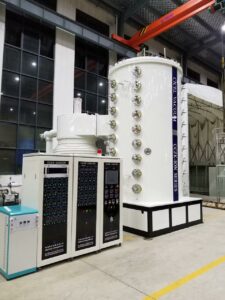
Not only does achieving exceptional finish quality drive pvd application efforts but also maximizing functional attributes of coated items remains at focus—for example, cutting tools enhanced via PVD acquire more resilience against wear-and-tear forces thereby
extending their lifespan dramatically alongside operational performance elevation—which exemplifies how pivotal this technological advancement has become throughout modern manufacturing practices.
Types of PVD Technologies
Physical Vapor Deposition (PVD) technologies encompass a variety of methods, each tailored to specific applications and materials. Among the most prominent are Sputtering, Thermal Evaporation, and Ion Deposition (e-beam).
Benefits of PVD Coatings
PVD coatings offer far more than improvements to the appearance of surfaces. They substantially enhance surface hardness and resistance to wear, which is a substantial benefit. PVD processes are capable of greatly diminishing friction—this aspect is particularly vital for applications that involve moving parts. The reduction in friction achieved through these coatings not only enhances the performance efficiency of mechanical systems, but also extends component lifespan by decreasing degradation from wear.
PVD coatings boast exceptional resistance against corrosion as well as an ability to perform under extreme temperatures, positioning them as prime options for challenging environments where alternative coating solutions might degrade or fail.
PVD coats have environmental advantages owing to their process reducing hazardous substances typically used in other coating procedures. This contributes toward creating a manufacturing environment that’s both safer and environmentally sustainable.
This amalgamation of enhanced functionality coupled with ecological consciousness renders PVD technology an excellent selection across numerous industrial uses due to its dual focus on operational excellence and sustainability.
Industrial Applications of Physical Vapor Deposition Coatings
PVD technology is utilized across a multitude of sectors, each reaping the benefits of its distinctive coating properties. Within the semiconductor sector, PVD plays an essential role in creating devices that demand consistent and high-quality thin films. When it comes to manufacturing cutting tools, coatings applied through PVD techniques contribute to greater durability and resistance to wear, resulting in coated cutting tools with extended service life and superior performance even under rigorous use.
The range of materials compatible with PVD for coatings showcases this method’s flexibility. Frequently selected materials include titanium nitride, zirconium nitride, chromium nitride, and titanium aluminum nitride. These substances are chosen for their ability to confer advantages like enhanced hardness levels, protection against corrosion, as well as improved thermal stability—features crucial for numerous industrial uses.
Such adaptability enables PVD processes to cater effectively to specialized requirements across diverse fields—from aerospace engineering all the way through automotive industries down to furniture design—which underscores its value within various markets.
Decorative and Functional Applications of PVD Coating
Physical Vapor Deposition (PVD) coatings are celebrated for their versatility, serving both decorative and functional purposes across various industries.
PVD Coating Materials and Targets
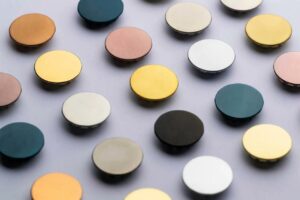
At the core of the PVD process, target materials or source materials are crucial as they are transformed into a vapor to form the coating. These targets encompass a wide variety of substances including metals, alloys, ceramics, and composite formulations. The broad spectrum of available materials enables custom-designed coatings suitable for unique purposes ranging from improving cutting tools’ robustness to adding ornamental finishes to furniture pieces.
For applications demanding specialized attributes like exceptional hardness and tolerance against high temperatures, coatings consisting of carbides, nitrides, silicides and borides come into play. Such specialized coatings excel in performance in intense industrial settings due to their specific property enhancements. By selectively utilizing different target materials during the PVD process’s execution strategy is what provides flexibility—granting it an ability to precisely align with diverse application necessities across various domains.
Safety and Durability of PVD Coatings
Preserving safety and enhancing longevity are crucial characteristics of coatings, with PVD standing out in both regards. Coatings applied using the PVD process are harmless, which makes them ideal for applications where there’s a high likelihood of human contact, such as residential areas and healthcare facilities. This benign quality is carried over into its manufacturing stages since PVD reduces reliance on hazardous substances thus promoting a safer production environment.
PVD coated surfaces boast an impressive ability to withstand discoloration, scratches, and corrosion. This robustness renders them perfect for scenarios demanding durable protection. Titanium nitride coatings exemplify this by offering not only an attractive aesthetic but also outstanding resistance to deterioration and corrosive damage — ensuring that the appearance and functionality of the surface remain intact through extended use.
This amalgamation of non-toxicity with enduring resilience positions PVD coatings as trustworthy options across various sectors requiring reliable surface protection solutions.
PVD Technologies and Techniques
The PVD process is a collective term for various methods, each presenting distinct advantages. In sputtering, one of the prevalent PVD techniques, energetic particles forcefully collide with a target material causing atoms or molecules to dislodge and settle on a substrate. This approach is exceptional in forming thin coatings that are evenly distributed and it serves an essential role in sectors like electronics, medical devices and optics.
Thermal evaporation deposition stands out as another widely adopted technique within the realm of the thin film deposition technology. It involves heating up the coating material until it evaporates and subsequently allowing it to condense onto the substrate. Its efficacy shines through when applying coatings onto intricately shaped surfaces.
Within the scope of specialized PVD technologies lies cathodic arc deposition, pulsed laser deposition, and electron beam PVD, among others. Each tailored for particular needs depending on their application area. The vast array of options available under PVD technology ensures that nearly any type of coating demand can be met effectively.
Why Use PVD for Furniture?
In the realm of furniture production, employing PVD processes melds practicality with aesthetics, delivering finishes that are robust against wear and tear while also being considerate to the environment. These PVD coatings ensure a persistent decorative sheen ideal for surfaces frequently touched such as door handles, table tops, and cabinet fixtures. The meticulous application secures a solid connection with the material surface, bolstering both endurance and visual appeal of furniture elements.
Through vaporizing solid materials within a vacuum chamber, PVD imparts an even and resilient coating onto various pieces of furniture. This method not only extends the lifespan, but also broadens design possibilities through an assortment of colors and textures available in these coatings. Consequently, it is seen as a compelling choice for designers aiming to craft eye-catching furnishings that maintain their integrity over time.
Key Benefits of PVD Coatings for Furniture
PVD coatings are advantageous for furniture as they not only boost its visual attractiveness but also increase its longevity. They deliver finishes that are resistant to both abrasion and corrosion, which helps the furniture components maintain their quality over time.
Aesthetic Appeal:
PVD coatings stand out for their capacity to add visual charm, offering a diverse selection of hues and finishes, including metallic shades, gold tones or a sleek matte black. These exceptionally thin yet robust layers amplify the aesthetic appeal of furniture pieces. This adaptability in customization empowers designers with an extensive array of materials, colors, and textures to impeccably align with any interior decor while delivering both functional attributes and stylistic enhancements.
PVD coating processes demonstrate environmental consciousness by reducing reliance on harmful substances typical in conventional coating methods. The resilience of these coatings is evident as they resist high temperatures and endure substantial wear, which makes them particularly suitable for furniture that experiences frequent use. Their fusion of elegance coupled with endurance positions PVD coatings as the favored option within contemporary furniture design circles.
Safety and Durability of PVD Coatings
The resilience and protection offered by PVD coatings are essential, particularly for furniture in residential and commercial settings. These coatings safeguard against scratches, tarnishing, and environmental harm to ensure prolonged preservation of the furniture’s aesthetics and practicality. The high durability makes them ideal for areas that see frequent usage, allowing furnishings to retain their appearance and functionality over time.
PVD technology ensures that the coatings are non-toxic, making them suitable even in environments where health safety is paramount, like medical institutions. Their adherence to strict safety regulations renders them perfect for application on furniture requiring higher standards of safety.
Examples from real life demonstrate the value proposition of these coated items. Interior designers often opt for PVD-coated furnishings when seeking a blend of luxury style with industrial-grade endurance—testifying to both aesthetic appeal as well as pragmatic advantages bestowed by PVD applications.
Comparison of PVD and CVD Coatings
Physical Vapor Deposition (PVD) and Chemical Vapor Deposition (CVD) are two prominent coating technologies, each with distinct processes and benefits.
References
- P. De Araujo and colleagues have presented an environmentally friendly option for protecting steel components from corrosion with their work on PVD aluminum alloy coatings, which was detailed in the journal Surface Engineering in 2003.
- In a study by O. Kahveci et al., featured in Surface Review and Letters (2017), a comparison is made between the parameters of Ti/n-GaAs Schottky contacts created using both DC Megatron sputtering and thermal evaporation methods.
- The durability impact of composite structures combining nitrided layers with PVD coatings on DIN-1.2367 steel forging dies was examined by J.Smolík et al., as documented in the journal Surface and Coatings Technology, published in 2004.
- Focusing on cutlery industry applications, P.Eh.Hovsepian’s research group explored CrN/NbN superlattice coatings produced through combined cathodic arc/unbalanced magnetron deposition techniques. Findings were shared via Surface & Coatings Technology magazine back in 2000.
5.M.Benelmekki’s team investigated silver clusters implanted into PET materials through the process known as “PVD stuttering” aimed at active packaging uses. Insights into structure and properties appear within the Journal of Nano Research’s edition for year 2012.
Summary
In summary, Physical Vapor Deposition (PVD) emerges as a groundbreaking method in the realm of surface coatings. Its remarkable advantages include improved durability, superior aesthetics, and eco-friendly attributes. PVD technology has fundamentally changed multiple sectors by increasing the robustness against wear on industrial equipment and offering modernized finishes for decorative items.
Looking ahead to what lies ahead, the prospects for Developments and uses of PVD are infinite. Adoption of PVD is instrumental in fostering products that not only excel in performance but also align with ecological sustainability, thereby playing an essential role in advancing contemporary production techniques and design concepts.
Conclusion
Physical Vapor Deposition (PVD) stands out as a versatile and highly effective coating technology, offering numerous benefits such as high purity, durability, and corrosion resistance. PVD coatings find applications across a wide range of industries, from decorative and functional uses to critical industrial applications.
The PVD coating process involves the evaporation of a target material in a high vacuum chamber first, followed by the deposition of a thin film onto a substrate. This process is supported by various PVD technologies, including Sputtering, Thermal Evaporation, and Ion Deposition (e-beam), each catering to specific needs and applications.
Overall, PVD coatings provide a reliable and efficient solution for diverse coating requirements. As industries continue to seek advanced and sustainable coating technologies, the adoption of PVD is expected to grow, driving innovation and enhancing product performance across multiple sectors.
Frequently Asked Questions
What is Physical Vapor Deposition (PVD)?
Physical Vapor Deposition (PVD) is a sophisticated coating technique that applies thin films at the atomic level, significantly improving material properties and delivering durable, high-quality finishes.
What are the benefits of PVD coatings?
PVD coatings enhance hardness, wear resistance, and reduce friction while providing corrosion resistance and durability.
These coatings are also environmentally friendly, making them a superior choice for various applications.
In which industries is PVD used?
Numerous sectors, such as those involved in semiconductor production, the creation of cutting tools, and furniture design, frequently employ PVD.
This versatility renders it an essential technique throughout these industries.
What materials can be used in PVD coatings?
PVD coatings can be created using metals, alloys, ceramics, and specialized compounds such as nitrides and carbides. This versatility allows for various applications across different industries.
Are PVD coatings safe for use in homes and offices?
PVD coatings are considered non-toxic and safe for application in residential and workplace settings.
Their incorporation into your living or working spaces can be done with assurance, knowing they do not pose a risk to health.


